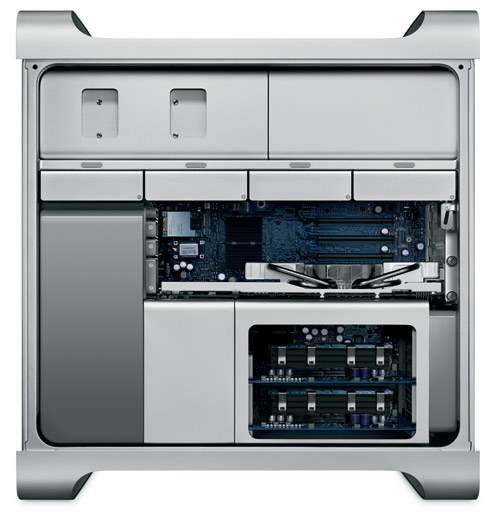Hosted by site sponsor WebMate.
Silver Tower Mac Pro (Dual Optical) Q&A - Revised February 4, 2008
All Mac Q&As >> Silver Tower Mac Pro Dual Optical Q&A (Home)
To be notified of new Q&As, sign up for EveryMac.com's bimonthly email list.
What are the differences between the original Mac Pro configurations?
Please note that all systems mentioned in this Q&A have been discontinued. The original Mac Pro models were replaced by the "Early 2008" Mac Pro models on January 8, 2008.
In recent history, Apple has offered systems in "Good", "Better", and "Best" configurations. Often the "Good" configuration shares technology with the previous generation of systems and only the "Better" and "Best" models offer the latest and greatest features.
However, this time, with the switch to Intel processors, Apple decided to simply offer one "suggested" model with numerous options available by custom configuration. All of the original Mac Pro systems, regardless of configuration, are powered by two Intel Xeon 5100 series processors -- either dual core (four cores total) or quad core (eight cores total) -- with 4 MB of shared level 2 cache per processor, a 128-bit SSE3 vector engine, and 1.33 GHz "64-bit dual independent frontside buses."
All of the original Mac Pro systems also use the same fantastically easy to upgrade case, packed with four easy to access "cable free" hard drive bays (marching across the middle in the photo below) that support Serial ATA 3Gb/s hard drives, two 5.25" optical drive bays (top left), eight fully buffered (FB-DIMM) slots on two easy access riser cards (bottom right), and four PCI Express expansion slots (one double-wide 16-lane PCI Express slot is occupied by the video card in the default configuration, and three full-length PCI Express expansion slots are open).

Photo Credit: Apple Computer
Obviously, all of the millions of combinations are a bit outside of the scope of this Q&A, but here is a comparison between the "suggested" configuration and a minimum "bare bones" configuration (the least expensive possible way to configure the Mac Pro).
| "Suggested" | "Bare Bones" | |
|---|---|---|
| Speed of Xeon Processors: | Dual Core 2.66 GHz x2 | Dual Core 2.0 GHz x2 |
| Memory: | 1.0 GB | 1.0 GB |
| Video Card: | NVIDIA GeForce 7300 GT | NVIDIA GeForce 7300 GT |
| Video Memory: | 256 MB | 256 MB |
| Hard Drive Capacity: | 250 GB | 160 GB* |
| Optical Drive: | 16X "SuperDrive" | 16X "SuperDrive" |
| Price: | US$2499 | US$2124* |
*On April 4, 2007, Apple dropped the 160 GB hard drive option. The least expensive configuration otherwise was identical but came with a 250 GB hard drive and sold for US$2200.
This "suggested" to "better" configuration may also be of interest. From August 7, 2006 to April 4, 2007, this was the fastest processor option available.
| "Suggested" | "Better" | |
|---|---|---|
| Speed of Xeon Processors: | Dual Core 2.66 GHz x2 | Dual Core 3.0 GHz x2 |
| Memory: | 1.0 GB | 2.0 GB |
| Video Card: | NVIDIA GeForce 7300 GT | ATI Radeon X1900 XT |
| Video Memory: | 256 MB | 512 MB |
| Hard Drive Capacity: | 250 GB | 500 GB |
| Optical Drive: | 16X "SuperDrive" | 16X "SuperDrive" |
| Price: | US$2499 | US$3975* |
*This configuration was US$4149 when configured on August 10, 2006. On April 4, 2007, Apple sold this configuration for US$3975.
On April 4, 2007, Apple began offering a system via custom configuration with two 3 GHz quad core Xeon X5365 processors (eight cores total) for an additional US$1498.
| "Suggested" | "Best" | |
|---|---|---|
| Speed of Xeon Processors: | Dual Core 2.66 GHz x2 | Quad Core 3.0 GHz x2 |
| Memory: | 1.0 GB | 2.0 GB |
| Video Card: | NVIDIA GeForce 7300 GT | ATI Radeon X1900 XT |
| Video Memory: | 256 MB | 512 MB |
| Hard Drive Capacity: | 250 GB | 500 GB |
| Optical Drive: | 16X "SuperDrive" | 16X "SuperDrive" |
| Price: | US$2499 | US$4674 |
To purchase a used Mac Pro, high-quality storage or memory for the Mac Pro, visit site sponsor Other World Computing.
Please refer to EveryMac.com's Ultimate Mac Comparison feature to dynamically compare any Mac Pro model to any other G3 or later Mac.
Permalink | Report an Error/Typo | Sign Up for Site Update Notices
<< Mac Pro Dual Optical Drives Q&A (Main) | All Mac Q&As
Established in 1996, EveryMac.com has been created by experts with decades of experience with Apple hardware. EveryMac.com includes, and always has included, original research incorporating detailed, hands-on inspection of packaging, computers, and devices as well as extensive real-world use. All information is provided in good faith, but no website or person is perfect. Accordingly, EveryMac.com is provided "as is" without warranty of any kind whatsoever. EveryMac.com, and the authors thereof, shall not be held responsible or liable, under any circumstances, for any damages resulting from the use or inability to use the information within. For complete disclaimer and copyright information please read and understand the Terms of Use and the Privacy Policy before using EveryMac.com. Copying, scraping, or use of any content without expressed permission is not allowed, although links to any page are welcomed and appreciated.
